[press release]
New Special Stamps from Royal Mail Celebrate Roman Life and Culture In Britain
- Eight new stamps explore the sophistication, technical brilliance and artistry of Roman Britain
- Featured in the set are: Dover Lighthouse; Bignor mosaic; Caerleon Amphitheatre; Ribchester helmet; Bridgeness distance slab; Warrior god, Cambridgeshire; Gorgon’s head, Bath; and Hadrian’s Wall
- For almost 400 years, much of mainland Britain was a province of the Roman Empire
- Royal Mail worked with the British Museum in the development of the stamp issue
- A full set of all eight stamps, available in a Presentation Pack, retails at £10.35
- The stamps and a range of collectible products are available to order now at www.royalmail.com/romanbritain and by phone on 03457 641 641
- The stamps will be available on general sale from Thursday 18 June
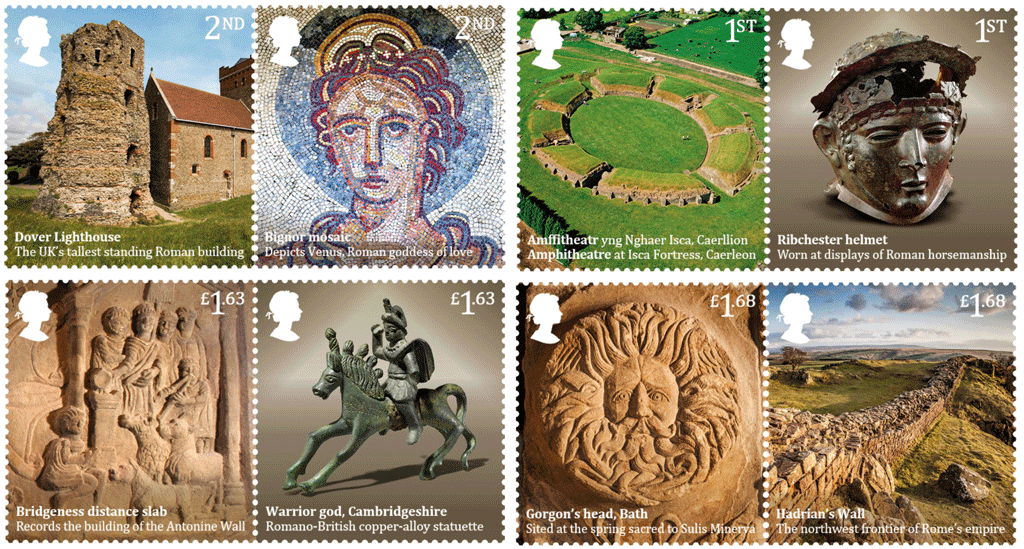
Royal Mail has revealed images from a new set of stamps being issued to celebrate Roman life and culture in Britain.
The eight stamps demonstrate the sophistication, technical brilliance and artistry of Roman Britain with images of sites and key artefacts – all of which remain in Britain today.
Featured in the set are: Dover Lighthouse; Bignor mosaic; Caerleon Amphitheatre; Ribchester helmet; Bridgeness distance slab; Warrior god, Cambridgeshire; Gorgon’s head, Bath; and Hadrian’s Wall.
Today, it is still possible to see the legacy of Rome by visiting standing remains such as Hadrian’s Wall and the amphitheatre at Newport or by seeking out the huge variety of Roman artefacts that can be viewed in museums across the UK.
Royal Mail worked with the British Museum in the development of the stamp issue.
Roman Britain:
For almost 400 years – 43 to 410 AD, much of mainland Britain was a province of the Roman empire. This period has a profound effect on British society, laws, language, art, architecture, culture and beliefs. Rome’s lasting legacy is visible in standing remains such as forts and villas and archaeological finds displayed in museums across the UK.
A large occupying army, estimated at around 55,000 men in the 2nd century, established a road network across much of lowland Britain, also facilitating the first public post system, the cursus publicus. Ermine Street, for example, linked London with Lincoln and York, three important towns.
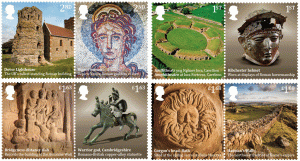 Indeed, although most Britons lived and worked in the countryside, continuing a way of life established for centuries, some settled in towns and participated in Roman social and cultural customs, such as public bathing or visiting the amphitheatre to be entertained. Wealthy landowners built villas – country residences on the Roman model, often floored with mosaics.
Indeed, although most Britons lived and worked in the countryside, continuing a way of life established for centuries, some settled in towns and participated in Roman social and cultural customs, such as public bathing or visiting the amphitheatre to be entertained. Wealthy landowners built villas – country residences on the Roman model, often floored with mosaics.
The economy was vibrant, with artisans producing everything from pottery beakers to iron tools, leather shoes and beer. Britain exported grain and metals, and slaves too, and imported goods from around the Mediterranean and beyond.
Tombstones and other inscriptions provide evidence of incomers from Italy and Rome’s European and eastern-Mediterranean provinces, and over time a distinctive Romano-British culture developed, as seen in objects such as brooches unique to Britain. Roman gods were worshipped alongside local deities, and Eastern mystery cults, and Christianity, were also popular.
Richard Hobbs, the Weston Curator of Roman Britain at the British Museum, said: “It was a great honour to work with Royal Mail on this project. The eight sites and objects chosen give a taste of life in Roman Britain, which I hope will encourage people to explore this fascinating period in Britain’s history further. The Ribchester helmet is not only one of the British Museum’s iconic items, but also one of our earliest acquisitions – it’s been in the national collection since 1796, when a hoard of Roman military equipment was discovered in Ribchester, Lancashire. The helmet, decorated with a scene of a battle between infantry and cavalry, was the most spectacular piece.”
Philip Parker, Royal Mail spokesperson, said: “What did the Romans do for us? They gave us important new towns, a network of roads to link them, vast building works in stone, a new language and our calendar – they even named the country, ‘Britain’. These new stamps feature some of the most complete and striking Roman sites and objects which show their character and sophistication.”
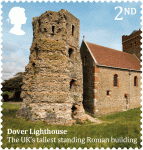 Dover Lighthouse
Dover Lighthouse
The Roman lighthouse – pharos – that adjoins the church of St Mary in the grounds of Dover Castle is the tallest surviving Roman building in Britain. Possibly modelled on the Pharos at Alexandria in Egypt, it probably stood to a height of around 24m. When it was in use, a beacon of fire would have been lit at night to guide ships in the Channel.
Bignor Mosaic
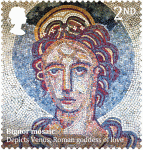 The Roman villa at Bignor, West Sussex, discovered in 1811 during ploughing, has some of the finest preserved mosaics from Roman Britain. The mosaic featured on the stamp, laid in an apsed room on the villa’s north side, probably dates to the early 4th century AD. It depicts a female head usually identified as the Roman goddess Venus.
The Roman villa at Bignor, West Sussex, discovered in 1811 during ploughing, has some of the finest preserved mosaics from Roman Britain. The mosaic featured on the stamp, laid in an apsed room on the villa’s north side, probably dates to the early 4th century AD. It depicts a female head usually identified as the Roman goddess Venus.
Amphitheatre, Caerleon
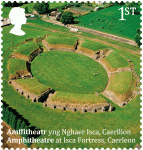 The amphitheatre at Caerleon (Isca) in southeast Wales (now in the north of the city of Newport) is the most complete to survive in Britain. It was built around AD 80, some years after the establishment of the nearby legionary fortress occupied by the Second Legion Augusta. The amphitheatre has a probable beast pen (carcer), in which animals and possibly humans were kept before their turn in the arena.
The amphitheatre at Caerleon (Isca) in southeast Wales (now in the north of the city of Newport) is the most complete to survive in Britain. It was built around AD 80, some years after the establishment of the nearby legionary fortress occupied by the Second Legion Augusta. The amphitheatre has a probable beast pen (carcer), in which animals and possibly humans were kept before their turn in the arena.
Ribchester Helmet
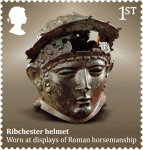 Discovered by a clogmaker’s son in 1796 at Ribchester, Lancashire, this helmet is one of the finest surviving examples of its type from anywhere in the Empire. It was worn by an expert cavalryman during cavalry sports events (hippika gymnasia) – flamboyant displays of military horsemanship and mounted weapons drill of great skill and timing. It is displayed at The British Museum.
Discovered by a clogmaker’s son in 1796 at Ribchester, Lancashire, this helmet is one of the finest surviving examples of its type from anywhere in the Empire. It was worn by an expert cavalryman during cavalry sports events (hippika gymnasia) – flamboyant displays of military horsemanship and mounted weapons drill of great skill and timing. It is displayed at The British Museum.
Bridgeness Distance Slab
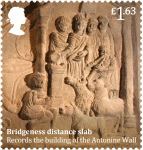 The Bridgeness distance slab at the eastern end of the Antonine Wall records its building by the Second Legion Augusta and documents the distance erected. The construction of the wall, primarily in turf, was ordered by Antoninus Pius in AD 138, and the wall ran from the Firth of Forth to the Firth of Clyde. It was occupied for only about 20 years. It is displayed at the National Museum of Scotland in Edinburgh.
The Bridgeness distance slab at the eastern end of the Antonine Wall records its building by the Second Legion Augusta and documents the distance erected. The construction of the wall, primarily in turf, was ordered by Antoninus Pius in AD 138, and the wall ran from the Firth of Forth to the Firth of Clyde. It was occupied for only about 20 years. It is displayed at the National Museum of Scotland in Edinburgh.
Warrior God
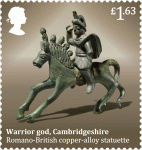 This attractive copper-alloy fgurine was discovered at Stow-cum-Quy in Cambridgeshire. Dating from the 3rd or 4th centuries AD, it depicts a helmeted rider on horseback who originally would have held a spear in his raised hand. The 8cm high figure is probably that of a local rider-god associated with Roman Mars and may have belonged to a shrine dedicated to the god. It is displayed at The British Museum.
This attractive copper-alloy fgurine was discovered at Stow-cum-Quy in Cambridgeshire. Dating from the 3rd or 4th centuries AD, it depicts a helmeted rider on horseback who originally would have held a spear in his raised hand. The 8cm high figure is probably that of a local rider-god associated with Roman Mars and may have belonged to a shrine dedicated to the god. It is displayed at The British Museum.
Gorgon’s Head
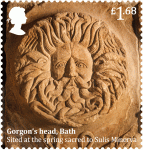 One of the most striking pieces of stone sculpture to survive from Roman Britain, this head occupied the pediment of the temple to Sulis Minerva at Bath, where it was set on a shield held aloft by Victories. An unusual portrayal of a male Gorgon, it also has echoes of Oceanus, the god of the oceans, an appropriate image for the sacred spring at the Roman Baths.
One of the most striking pieces of stone sculpture to survive from Roman Britain, this head occupied the pediment of the temple to Sulis Minerva at Bath, where it was set on a shield held aloft by Victories. An unusual portrayal of a male Gorgon, it also has echoes of Oceanus, the god of the oceans, an appropriate image for the sacred spring at the Roman Baths.
Hadrian’s Wall
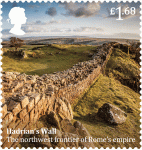 Hadrian’s Wall is the largest surviving Roman-era monument in Britain. Its construction followed Emperor Hadrian’s visit to the province in AD 122. A stone wall with milecastles, forts and a ditch, it formed a continuous barrier running from the River Tyne at Newcastle to Bowness on the Solway. Its likely purpose was to control tribal activity on both sides of the frontier.
Hadrian’s Wall is the largest surviving Roman-era monument in Britain. Its construction followed Emperor Hadrian’s visit to the province in AD 122. A stone wall with milecastles, forts and a ditch, it formed a continuous barrier running from the River Tyne at Newcastle to Bowness on the Solway. Its likely purpose was to control tribal activity on both sides of the frontier.
The full range of stamps, and other collectible products are available now at www.royalmail.com/romanbritain and by phone on 03457 641 641.
The full set of eight stamps, available in a Presentation Pack, retails at £10.35.
The stamps will go on general sale from 18 June 2020.



